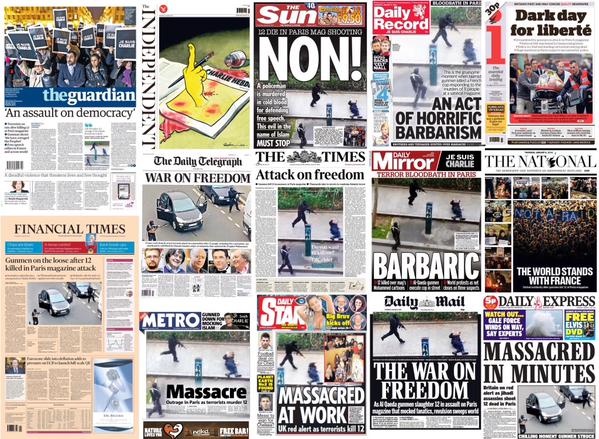 Attacks on press freedom traditionally provoke a strong response from newspaper editors around the world, and Wednesday’s horrific attack on the offices of Charlie Hebdo was no exception.
Attacks on press freedom traditionally provoke a strong response from newspaper editors around the world, and Wednesday’s horrific attack on the offices of Charlie Hebdo was no exception.
As French police hunted for two suspects still on the run, headlines in Thursday’s printed press reported the shooting with a potent mix of defiance and grief.
French daily Libération ran a black front page with the words in bold white: “Nous Sommes Tous Charlie” — “We are all Charlie,” echoing the crowds that took to the streets of Paris and other major cities to denounce the attack.
L’Equipe, a French daily covering sports, ran a full-page cartoon showing stunned and teary sports fans with the headline “Liberté 0 – Barbarie 12,” alluding to the 12 people — 10 journalists and two police officers — who were killed in the assault.
Le Figaro was one of a number of newspapers that printed an image showing the gunmen at the scene. Its headline declared “La liberté assassinée,” or “freedom assassinated.”
In a strongly worded column, the paper’s editorial director, Alexis Brézet, called for a vigorous defense to the threats to press freedom, accusing the gunmen of striking at the heart of free expression.
Le Télégramme’s front page branded the word “assassinés” across the names of the magazine and the known victims, the magazine’s leading cartoonists and editors who were gunned down during a morning meeting. The front page of Germany’s Bild called it a “cowardly murder.”
In the United Kingdom, The Telegraph said the attack was a “War on Freedom,” while The Guardian called it “An assault on democracy.”
An accompanying editorial in The Guardian said the events were “beyond belief, indeed beyond words.”
“The hooded thugs trained their Kalashnikovs on free speech everywhere. If they are allowed to force a loss of nerve, conversation will become inhibited, and liberty of thought itself will falter too.”
The Times of London ran a front-page image of the shocking moment that one gunman pointed his weapon at a wounded police officer lying on the ground, with the words, “Do you want to kill me?” The headline ran “Attack on Freedom.”
The choice of photo attracted fierce criticism on social media with users condemning it as “way too graphic” and “highly disrespectful.” One user tweeted, “Why show the one image they want you to print, and not the cartoons?”

The Independent took a different tack, running a full-page image of a bloodied cover of Charlie Hebdo, with a hand emerging showing a raised middle finger. The yellow hand was holding a nib dripping with red ink. Fittingly, there were no words.
In the United States, an editorial in The New York Times praised French President Francois Hollande for his appeal for national unity. This is “no time for peddlers of xenophobia to try to smear all Muslims with a terrorist brush.”
An opinion piece in The Washington Post draws a link to the recent cyberattack against Sony, saying “Suddenly, satire is the great issue of our time.” Cartoonists, it says, “take big risks, bigger than perhaps even they realize or anticipate,” and Western democracies must “rally to their unequivocal defense.”
Danish daily broadsheet Politiken also chose to lead with a drawing: a simple image of a pencil that appears to break while drawing a line, which paused … then continued on.
In Germany, national daily Das Bild ran a front-page image of one of the gunmen shooting a police officer on the ground. “Cowardly murderer,” said the headline. The paper also has a piece quoting Danish cartoonist Kurt Westergaard, known for his controversial depictions of the Prophet Mohammed, in which he insists that despite the fear many journalists feel, himself included, they must continue to use satire.
The front page of Belgium’s De Standaard reproduces a 2011 Charlie Hebdo cartoon of two men kissing deeply, one who appears to be Muslim and the other wearing a Charlie Hebdo T-shirt with a pencil behind his ear. “Love is stronger than hate,” is written above it in French.
Haaretz didn’t share that sentiment. “I’m afraid the bad guys have already won. No cartoonist or publisher anywhere would dare start up with them now,” said a headline on the English edition of the Israeli newspaper.
The Gulf News, published in the United Arab Emirates, ran the story on its front page with a picture of a survivor being carried away on a stretcher and a box titled “UAE solidarity — raid condemned.”

An editorial says the attackers “violated all human principles and ethical values and deserve to be caught and tried for their disgusting acts,” and their actions had “nothing to do with Islam.”
Charlie Hebdo had published cartoons of Mohammed “that were certainly offensive to many Muslims,” it said. “But that is no reason to kill anyone, nor to commit any such act of gross violence.”
The English-language Kuwait Times also had a front-page picture of one of the injured being carried away on a stretcher. The Arab Times, also published in Kuwait, ran that image and two others showing the police response. A headline in red ink read: “Worst terrorist attack on French soil condemned.”
India’s Telegraph newspaper, published in Calcutta, ran the headline “Bullet through a tradition” next to an image of a bullet hole in a window near the attack scene. The story also made the front page of the New Indian Express and Pakistan’s Dawn newspaper.
CNN
Leave a Reply
You must be logged in to post a comment.